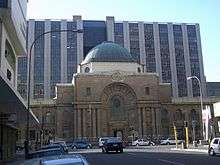Labour Court of South Africa
| Labour Court of South Africa | |
|---|---|
| Established | 1995 |
| Country | South Africa |
| Location | Johannesburg, Cape Town, Durban, Port Elizabeth |
| Composition method | Presidential appointment on the advice of the JSC and NEDLAC |
| Authorized by | Labour Relations Act, 1995 |
| Decisions are appealed to | Labour Appeal Court |
| Website |
www |
| Judge President | |
| Currently | Basheer Waglay |
| Deputy Judge President | |
| Currently | Lazarus Pule Tlaletsi |
The Labour Court is a South African court that handles labour law cases, that is, disputes arising from the relationship between employer, employee and trade union. The court was established by the Labour Relations Act, 1995, and has a status similar to that of a division of the High Court. It has its seat in Johannesburg and branches in Cape Town, Port Elizabeth and Durban.
Judges of the Labour Court, who must be High Court judges or lawyers with experience in labour law, are appointed by the President, acting on the advice of the Judicial Service Commission and the National Economic Development and Labour Council. The court is headed by a Judge President (JP) and a Deputy Judge President (DJP) and there are nine other judges on the court.[1] Each case before the court is heard by a single judge.
The Labour Court has exclusive jurisdiction over cases arising from the Labour Relations Act, 1995, which deals with collective bargaining, trade unions, strikes and lockouts, unfair dismissal and unfair labour practices; the Basic Conditions of Employment Act, 1997, which deals with working hours, leave and remuneration; the Employment Equity Act, 1998, which deals with discrimination and affirmative action; and the Unemployment Insurance Act, 2001. These matters are removed from the jurisdiction of the ordinary High Courts. Judgments of the Labour Court can be appealed to the Labour Appeal Court or the Supreme Court of Appeals which in turn can be appealed to the Constitutional Court of South Africa.
See also
References
- ↑ "Labour Court". Judges by Court. Juta Law. Retrieved 18 April 2012.
External links
- Official website
- Judgments of the Labour Court until 2010
- Judgments of the Labour Court, Cape Town since 2011
- Judgments of the Labour Court, Johannesburg since 2011
- Judgments of the Labour Court, Port Elizabeth since 2011
- Judgments of the Labour Court, Durban since 2011
